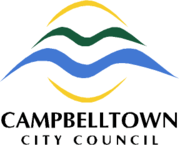City of Campbelltown (South Australia)
| City of Campbelltown South Australia | |||||||||||||
|---|---|---|---|---|---|---|---|---|---|---|---|---|---|
 | |||||||||||||
| Population | 49,281 (2009)[1] | ||||||||||||
| • Density | 1,838/km2 (4,760/sq mi) | ||||||||||||
| Area | 24.35 km2 (9.4 sq mi) | ||||||||||||
| Mayor | Simon Brewer | ||||||||||||
| Council seat | Rostrevor | ||||||||||||
| Region | Metropolitan Adelaide | ||||||||||||
| State electorate(s) | Morialta, Hartley | ||||||||||||
| Federal Division(s) | Mayo, Sturt | ||||||||||||
 | |||||||||||||
| Website | City of Campbelltown | ||||||||||||
| |||||||||||||
The City of Campbelltown is a local government area in the north eastern suburbs of Adelaide, South Australia about 6 kilometres from the Adelaide GPO. The City is bordered by the River Torrens and the City of Tea Tree Gully, the District of Adelaide Hills, the City of Burnside, the City of Norwood Payneham St Peters, and the City of Port Adelaide Enfield. The City has an estimated population of 49,281 people.[1]
History
The name "Campbelltown" was decided upon at a meeting held at the Glynde Inn on 9 December 1867. The city was named after Charles James Fox Campbell. The Campbelltown District became a town on 1 January 1946 and was proclaimed a city on 6 May 1960.[2]
Lochend
Campbell purchased Sections 309 and 310 on a fertile plain near the River Torrens in 1842 and built a home he called "Lochend" after the ancestral home of his family in Scotland. Lochend was built of local river stone and included a stucco porch, hall and living room with a finely moulded ceiling. Campbell later substantially expanded Lochend by the addition of three bedrooms and a cellar. Lochend included 4 acres (1.6 ha) of garden and 156 acres (63 ha) in the estate, primarily used as pastoral land. In 1849 he subdivided 16 acres (6.5 ha) into 40 gardening blocks under the name "Campbelltown".
In 1852, Campbell leased the house to James Scott. By this time, the house had six rooms. Campbell sold Lochend to Scott in 1858 for 2,600 pounds, and Scott lived there until 1875. The Scott family enlarged the house to eleven rooms, a stable, coach house and cottage, all surrounded by vegetable and fruit gardens and 58 acres of crop growing land. The next owner, retired sheep farmer David Mundy, built the two storey house Lochiel Park, on a rise just to the south of Lochend. From 1898 to 1957, Lochend and Lochiel Park were owned or lived in by members of the Hobbs family. The Hobbs sold both houses to the SA Government in 1947, and Lochiel Park became a junior boys' reformatory.[3]
In the early 1980s, ownership of Lochend was transferred to Campbelltown Council. Empty, partly demolished and isolated, Lochend had deteriorated, was in a dangerous condition, and was in almost irretrievable condition. In 1998 Campbelltown Council began efforts to save the building; it was faithfully restored to near original condition with the guidance of the Campbelltown Historical Society, and was officially reopened on 29 February 2004.[2][3][4][5]
Lochiel Park development
In 2004 the South Australian Government announced the development of an ecovillage named Lochiel Park on the site "of a former education institution", (the Lochiel Park junior boys' reformatory).[6] The development was planned to cover an area bounded by the River Torrens (west), Lochend House, grounds and entry road (north), Hobbs House (east), the O-Bahn (south-east), and a wet-land (south).[7]
Announcing the Development Premier Mike Rann said: "I want South Australia to become a world leader in a new green approach to the way we all live. The Lochiel Park Development will become the national model 'Green Village' incorporating ecological sustainable development technologies".[8]
Work on the development began in 2006, and by 2010 there were 60 residents at the site.[9][10] It has been touted as "an exemplary 'green' urban development incorporating 'best practice sustainable technologies' to assist in educating the public and industry about sustainable housing and land development".[11] However, "opinion remains divided about the worth of a so-called 'green village' at the site".[12][13][14]
Suburbs
- Athelstone (5076)
- Campbelltown (5074)
- Hectorville (5073)
- Magill (5072)
- Newton (5074)
- Paradise (5075)
- Rostrevor (5073)
- Tranmere (5073)
See also
References
- 1 2 Australian Bureau of Statistics (30 March 2010). "Regional Population Growth, Australia, 2008–09". Retrieved 4 June 2010.
- 1 2 History of Campbelltown, www.campbelltown.sa.gov.au
- 1 2 "Lochend". Campbelltown.sa.gov.au. City of Campbelltown. Retrieved 9 March 2011.
- ↑ Tony Ryan (2005) Lochend House Fact Sheet, 27 May 2005, Take Time, 89.7 PBA FM, www.learningworksradio.com
- ↑ Interview with Campbelltown City Councillor Mike Boyle, 27 May 2005, 89.7 PBA FM, about the restoration of Lochend House. (Audio (MP3) 2.5Mb), www.learningworksradio.com
- ↑ "Lochiel Park website: Home page". LochielPark.com.au. Government of South Australia: Land Management Corporation. Retrieved 9 March 2011.
- ↑ "Lochiel Park Master Concept Plan update" (PDF). LochielPark.com.au. Government of South Australia: Land Management Corporation. Retrieved 9 March 2011.
- ↑ HIA GreenSmart Awards-Architecture and Design, 21 May 2009/ www.architectureanddesign.com.au/
- ↑ Dupree, Brittany (9 March 2011). "A decade of disagreement". East Torrens Messenger.
- ↑ Whitford, Jane (22 June 2010). "Green edition: It's solar, so good for Lochiel Park couple". East Torrens Messenger. Retrieved 10 March 2011.
- ↑ "Lochiel Park "Green Village"". Campbelltown.sa.gov.au. City of Campbelltown. Retrieved 9 March 2011.
- ↑ Dupree, Brittany (8 March 2011). "Lochiel Park division". East Torrens Messenger. Retrieved 10 March 2011.
- ↑ Dupree, Brittany (8 March 2011). "Ecologist questions park's credentials". East Torrens Messenger. Retrieved 10 March 2011.
- ↑ Dupree, Brittany (8 March 2011). "Conlon sticks to his guns". East Torrens Messenger. Retrieved 10 March 2011.
External links
| ||||||||||||||||||||||||||||||
Coordinates: 33°53′S 151°15′E / 33.883°S 151.250°E